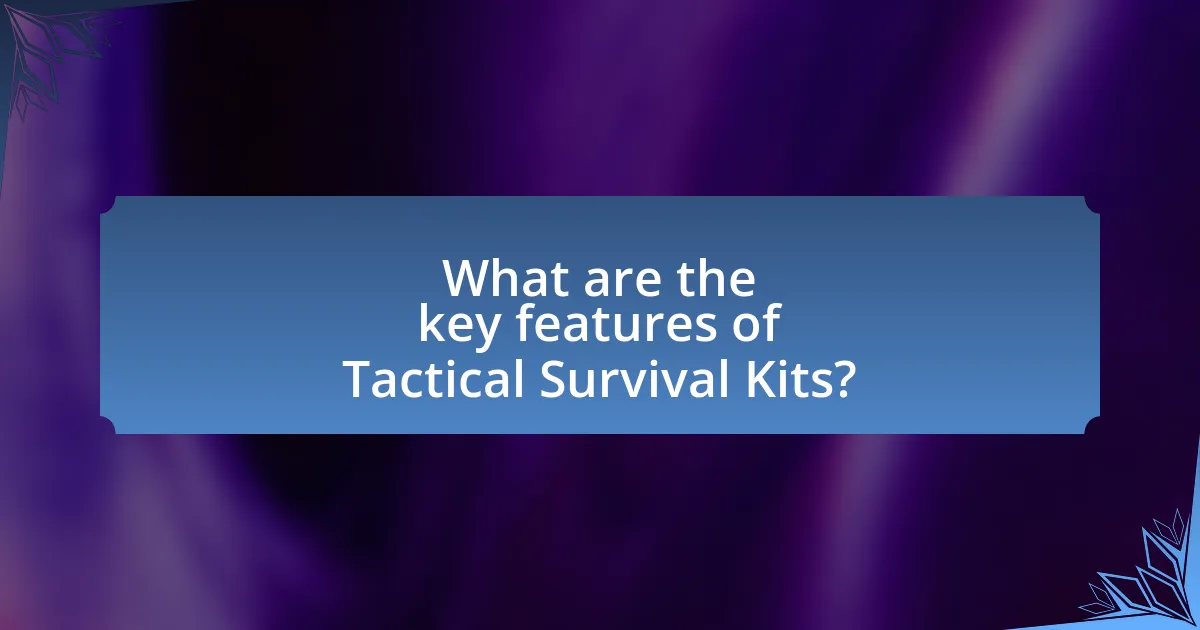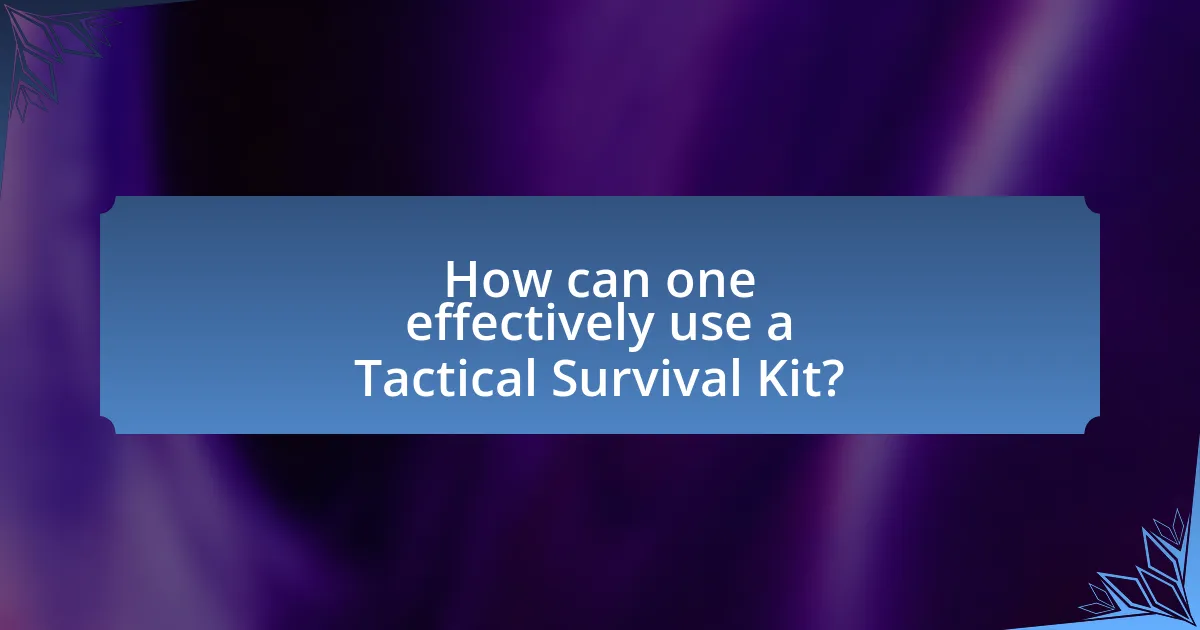Tactical survival kits are specialized collections of tools and supplies designed to assist individuals in emergency situations, particularly in outdoor or survival scenarios. These kits include essential items such as first aid supplies, fire-starting tools, water purification systems, and navigation aids, tailored for high-stress situations. The article explores the differences between tactical and regular survival kits, essential components, and the importance of customization and portability. It also discusses best practices for maintaining these kits, effective usage, and common mistakes to avoid, emphasizing the significance of preparedness in enhancing survival rates during emergencies.

What are Tactical Survival Kits?
Tactical survival kits are specialized collections of tools and supplies designed to assist individuals in emergency situations, particularly in outdoor or survival scenarios. These kits typically include essential items such as first aid supplies, fire-starting tools, water purification systems, and navigation aids. The purpose of tactical survival kits is to provide users with the necessary resources to sustain themselves and navigate challenges in adverse conditions, enhancing their chances of survival. The effectiveness of these kits is supported by their comprehensive design, which addresses various survival needs, making them valuable for outdoor enthusiasts, military personnel, and emergency responders.
How do Tactical Survival Kits differ from regular survival kits?
Tactical survival kits differ from regular survival kits primarily in their design and intended use. Tactical survival kits are specifically tailored for high-stress, high-risk situations, often incorporating advanced tools and equipment that support military, law enforcement, or outdoor survival scenarios. In contrast, regular survival kits typically contain basic supplies aimed at general emergencies, such as food, water, and first aid items.
For example, tactical kits may include items like multi-tools, tactical flashlights, and specialized medical supplies, which are not commonly found in standard survival kits. This distinction is supported by the fact that tactical kits are often used in scenarios requiring quick decision-making and adaptability, such as wilderness survival or urban emergencies, whereas regular kits are designed for more straightforward situations like natural disasters.
What essential components are typically included in Tactical Survival Kits?
Tactical Survival Kits typically include essential components such as a multi-tool, first aid supplies, fire-starting equipment, water purification methods, food rations, signaling devices, and shelter materials. These components are crucial for survival in emergency situations, providing the necessary tools for self-defense, medical assistance, and sustenance. For instance, multi-tools offer versatility for various tasks, while first aid supplies are vital for treating injuries. Fire-starting equipment ensures warmth and cooking capabilities, and water purification methods are essential for safe drinking water. Food rations provide necessary nutrition, signaling devices enable communication for rescue, and shelter materials protect against environmental elements.
Why are specific tools chosen for Tactical Survival Kits?
Specific tools are chosen for Tactical Survival Kits to ensure versatility, reliability, and effectiveness in emergency situations. Each tool is selected based on its ability to address a range of survival needs, such as shelter building, food procurement, first aid, and navigation. For instance, multi-tools are favored for their multifunctionality, allowing users to perform various tasks without carrying multiple items. Additionally, tools like fire starters and water purification systems are critical for sustaining life in survival scenarios. The selection process often considers factors such as weight, durability, and ease of use, ensuring that the kit remains practical and efficient under stress.
What scenarios are Tactical Survival Kits designed for?
Tactical Survival Kits are designed for emergency situations, outdoor survival, and disaster preparedness. These kits typically include essential tools and supplies to address various scenarios such as natural disasters (like hurricanes or earthquakes), wilderness survival (including camping or hiking emergencies), and urban emergencies (like civil unrest or power outages). The inclusion of items like first aid supplies, fire-starting tools, and water purification systems supports individuals in effectively managing life-threatening situations and enhancing their chances of survival.
How do Tactical Survival Kits prepare users for emergencies?
Tactical Survival Kits prepare users for emergencies by equipping them with essential tools and supplies needed to respond effectively in crisis situations. These kits typically include items such as first aid supplies, water purification systems, multi-tools, and emergency food rations, which are critical for survival in scenarios like natural disasters or outdoor emergencies. Research indicates that preparedness significantly increases survival rates; for instance, a study by the Federal Emergency Management Agency (FEMA) found that individuals with emergency kits are 60% more likely to manage crises effectively. This evidence underscores the importance of Tactical Survival Kits in enhancing user readiness and resilience during emergencies.
What types of environments are Tactical Survival Kits most effective in?
Tactical Survival Kits are most effective in wilderness, urban disaster, and extreme weather environments. In wilderness settings, these kits provide essential tools for navigation, shelter, and food procurement, which are critical for survival. In urban disaster scenarios, such as earthquakes or floods, they offer supplies for first aid, communication, and self-defense. Additionally, in extreme weather conditions, these kits include gear to protect against hypothermia or heat exhaustion, ensuring safety and survival. The versatility of Tactical Survival Kits makes them indispensable across these varied environments.

What are the key features of Tactical Survival Kits?
Tactical Survival Kits are designed to provide essential tools and supplies for survival in emergency situations. Key features include multi-functional tools, such as knives and fire starters, which facilitate various survival tasks; first aid supplies to address medical emergencies; water purification systems to ensure safe drinking water; and food rations that sustain energy levels. Additionally, these kits often contain navigation aids like compasses and maps, signaling devices for rescue, and durable, weather-resistant packaging to protect contents. The inclusion of these features ensures that users are equipped to handle a range of survival scenarios effectively.
How does portability impact the design of Tactical Survival Kits?
Portability significantly influences the design of Tactical Survival Kits by necessitating lightweight materials and compact configurations. Designers prioritize minimizing weight and size to ensure that users can easily carry the kits during emergencies or outdoor activities. For instance, the use of multi-functional tools and modular components allows for efficient packing without sacrificing essential items. Additionally, research indicates that survival kits designed for portability often incorporate durable, weather-resistant materials to withstand various environmental conditions while remaining lightweight. This focus on portability ensures that Tactical Survival Kits are practical and accessible in critical situations.
What materials are commonly used in the construction of Tactical Survival Kits?
Tactical Survival Kits are commonly constructed using durable materials such as nylon, polyester, and metal. Nylon and polyester provide water resistance and durability, making them ideal for carrying essential gear. Metal components, such as tools and containers, ensure reliability and longevity under harsh conditions. These materials are chosen for their ability to withstand extreme environments, as evidenced by their widespread use in military and outdoor applications, where resilience and functionality are critical.
How do the sizes of Tactical Survival Kits vary based on their intended use?
Tactical Survival Kits vary in size based on their intended use, with smaller kits designed for short-term emergencies and larger kits tailored for extended survival situations. For instance, a compact kit suitable for day hikes may include essential items like a first aid kit, water purification tablets, and a multi-tool, while a larger kit intended for prolonged outdoor survival might contain additional gear such as a tent, sleeping bag, and cooking equipment. This differentiation in size and contents ensures that users have the appropriate resources for their specific survival scenarios, enhancing their chances of success in various environments.
What role does customization play in Tactical Survival Kits?
Customization plays a crucial role in Tactical Survival Kits by allowing individuals to tailor the contents to their specific needs and environments. This personalization enhances the effectiveness of the kit, ensuring that users have the right tools and supplies for their unique situations, whether for outdoor adventures, emergency preparedness, or military applications. For instance, a study by the National Outdoor Leadership School highlights that customized gear can significantly improve user confidence and performance in survival scenarios, as it aligns with personal skills and preferences.
How can users personalize their Tactical Survival Kits for specific needs?
Users can personalize their Tactical Survival Kits by assessing their specific needs based on factors such as environment, duration of use, and individual skills. For instance, a user in a wilderness setting may prioritize items like a water filtration system and fire-starting tools, while someone preparing for urban emergencies might focus on first aid supplies and self-defense items. Additionally, users can customize their kits by including personal medications, specialized gear for hobbies like fishing or hiking, and tools that match their skill level, ensuring that the kit is tailored to their unique circumstances and enhances their preparedness.
What are the benefits of having a modular Tactical Survival Kit?
A modular Tactical Survival Kit offers the benefit of customization, allowing users to tailor the contents to specific needs and scenarios. This adaptability ensures that individuals can include essential tools and supplies relevant to their environment, whether for outdoor adventures, emergency preparedness, or survival situations. Furthermore, modular kits facilitate organization, enabling users to easily access and replace items as needed, which enhances efficiency during critical moments. Studies indicate that preparedness significantly increases survival rates in emergencies, underscoring the importance of having a well-organized and personalized survival kit.

How can one effectively use a Tactical Survival Kit?
To effectively use a Tactical Survival Kit, one must first familiarize themselves with the contents and their specific purposes. Understanding how each item functions—such as tools for shelter building, fire starting, and first aid—enables efficient and practical application in survival scenarios. For instance, a multi-tool can serve various functions, from cutting to screwing, which is essential in emergency situations.
Additionally, practicing the skills associated with each item, such as using a fire starter or setting up a tarp for shelter, enhances preparedness. Regular drills or simulations can reinforce these skills, ensuring that an individual can act quickly and effectively when needed.
Research indicates that preparedness training significantly increases survival rates in emergencies, highlighting the importance of not only having a kit but also knowing how to use it effectively.
What are the best practices for maintaining a Tactical Survival Kit?
The best practices for maintaining a Tactical Survival Kit include regular inventory checks, ensuring all items are functional, and replacing expired supplies. Regular inventory checks help identify missing or damaged items, ensuring the kit is always ready for use. Ensuring all items are functional involves testing equipment like flashlights and tools to confirm they operate correctly. Replacing expired supplies, such as food and medical items, is crucial for safety and effectiveness, as expired items can compromise the kit’s purpose. Following these practices ensures that a Tactical Survival Kit remains reliable and effective in emergencies.
How often should the contents of a Tactical Survival Kit be checked or updated?
The contents of a Tactical Survival Kit should be checked or updated at least every six months. Regular checks ensure that items remain functional, that perishables are replaced, and that the kit is tailored to current needs or potential threats. According to survival experts, this biannual review helps maintain readiness and effectiveness in emergency situations.
What steps should be taken to ensure readiness before an emergency?
To ensure readiness before an emergency, individuals should create an emergency plan, assemble a survival kit, and conduct regular training. An emergency plan outlines specific actions to take during various emergencies, ensuring everyone knows their roles and responsibilities. Assembling a survival kit involves gathering essential supplies such as food, water, first aid items, and tools, which should be tailored to the specific needs of the household. Regular training, including drills and simulations, reinforces preparedness and helps individuals respond effectively under pressure. According to the Federal Emergency Management Agency (FEMA), having a plan and supplies can significantly improve survival rates during emergencies.
What tips can enhance the effectiveness of a Tactical Survival Kit?
To enhance the effectiveness of a Tactical Survival Kit, ensure it includes essential items tailored to specific environments and scenarios. A well-rounded kit should contain tools for shelter, fire-starting, water purification, first aid, and food procurement. For instance, incorporating a multi-tool can provide versatility for various tasks, while a reliable fire starter ensures warmth and cooking capabilities. Additionally, regularly updating the kit to replace expired items and adapting it based on seasonal changes or personal needs increases its reliability. Research indicates that preparedness significantly improves survival outcomes, emphasizing the importance of a comprehensive and well-maintained kit.
How can training improve the use of a Tactical Survival Kit in real situations?
Training enhances the use of a Tactical Survival Kit in real situations by equipping individuals with the necessary skills and knowledge to effectively utilize the kit’s components. Through structured training, users learn how to identify and prioritize survival needs, such as shelter, water, and food, which are critical in emergency scenarios. For instance, a study by the National Outdoor Leadership School indicates that individuals who undergo survival training are 70% more likely to successfully navigate emergency situations compared to those without training. This training also fosters familiarity with the kit’s tools, enabling quicker and more efficient responses during crises.
What common mistakes should be avoided when using a Tactical Survival Kit?
Common mistakes to avoid when using a Tactical Survival Kit include neglecting to regularly check and update the kit’s contents, which can lead to expired or unusable items. Users often overlook the importance of familiarizing themselves with the equipment, resulting in ineffective use during emergencies. Additionally, failing to tailor the kit to specific environments or personal needs can diminish its effectiveness. Lastly, many individuals do not practice using the kit, which can hinder their ability to respond quickly and efficiently in a crisis.


